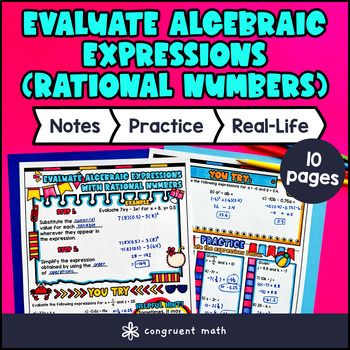Want more ideas and freebies?
Get my free resource library with digital & print activities—plus tips over email.
Join for Free Resources →
$4.25
Ever wondered how to teach evaluating algebraic expressions in an engaging way to your 7th grade students? In this lesson plan, students will learn about evaluating algebraic expressions through substitution of rational numbers using guided notes and doodles. They will practice substituting rational numbers for variables using order of operations. The lesson culminates with a real-life example that explores how evaluating algebraic expressions can be used in everyday situations.

$4.25
After this lesson, students will be able to:
Before this lesson, students should be familiar with:
As a hook, ask students why it is important to be able to evaluate algebraic expressions. Refer to the last page of the guided notes, which focuses on a real-life math application, for ideas on how to frame this question. Encourage students to think about situations where they need to substitute values for variables in order to find a final answer.
Use the first page of the guided notes to introduce the concept of evaluating algebraic expressions through substitution. Walk through the key points of the topic, including how to substitute and simplify, as well as the use of rational numbers such as positive and negative integers, decimals, and fractions. Emphasize the importance of following the order of operations when evaluating expressions. Refer to the FAQ below for a walk through on this, as well as ideas on how to respond to common student questions.
Based on student responses and understanding, reteach any concepts that students may need extra help with. If your class has a wide range of proficiency levels, consider pulling out students for reteaching while more advanced students begin working on the practice exercises.
Have students practice evaluating algebraic expressions using the practice worksheet provided in the resource (pg. 2). They can work individually or in pairs to complete the maze activity (pg. 3) or color by number worksheet (pg. 4).
As students work on the practice worksheet, circulate around the classroom to answer any questions they may have and provide support as needed.
For fast finishers, they can move on to the real-life application activity included in the resource. This activity allows students to read and write about real-life uses of evaluating algebraic expressions. You can assign it as homework for the remainder of the class, or for further practice at home.
Use the last page of the guided notes to bring the class back together, and introduce the concept of real-world applications of evaluating algebraic expressions. This concept is used in various real-life situations such as calculating the cost of a shopping trip, determining the total distance traveled on a road trip, or estimating the amount of time needed to complete a task.
To engage students in this topic, you can provide examples and scenarios where evaluating algebraic expressions is necessary. For example, you can present a scenario where a person is shopping for groceries and needs to calculate the total cost of the items they are purchasing. Ask students to identify variables in the situation, such as the price of each item and the quantity of each item. Then, guide students through the process of replacing the variables with specific numerical values and evaluating the expression to find the total cost.
You can also discuss real-life situations that involve algebraic expressions with negative numbers. For instance, consider a scenario where a person is driving and needs to calculate the total distance traveled. In this case, variables could represent distances traveled in different directions, where positive values indicate forward movement and negative values indicate backward movement. Students can substitute specific values for the variables and evaluate the expression to find the total distance traveled.
Encourage students to think about other real-life situations where evaluating algebraic expressions might be useful. This will help them understand the relevance and practicality of the topic in their everyday lives.
Refer to the FAQ section of the resource for more ideas and examples on how to teach real-life applications of evaluating algebraic expressions.
If you’re looking for digital practice for evaluating algebraic expressions through substitution, try my Pixel Art activities in Google Sheets. Every answer is automatically checked, and correct answers unlock parts of a mystery picture. It’s incredibly fun, and a powerful tool for differentiation.
Here are 3 activities to explore:
A fun, no-prep way to practice evaluating algebraic expressions through substitution is Doodle Math — they’re a fresh take on color by number or color by code. It includes multiple levels of practice, perfect for a review day or sub plan.
Here is one activity to try:
Evaluating algebraic expressions involves substituting values for variables in an algebraic expression and simplifying the expression to find the numerical value.
To evaluate algebraic expressions, follow these steps:
The order of operations is a set of rules that determines the sequence in which operations should be performed in an expression. The acronym PEMDAS can help you remember the order:
Certainly! Let's evaluate the expression 3x + 2y when x = 4 and y = 5:
When evaluating algebraic expressions with negatives, it's important to keep track of the signs. Here's an example:
Yes, you can use fractions when evaluating algebraic expressions. If the expression involves fractions, make sure to perform any necessary operations to simplify the fractions before substituting the values.
The distributive property allows you to simplify expressions that involve multiplication. To use the distributive property when evaluating algebraic expressions, follow these steps:
Evaluating algebraic expressions is useful in many real-life situations, such as:
Get my free resource library with digital & print activities—plus tips over email.
Join for Free Resources →